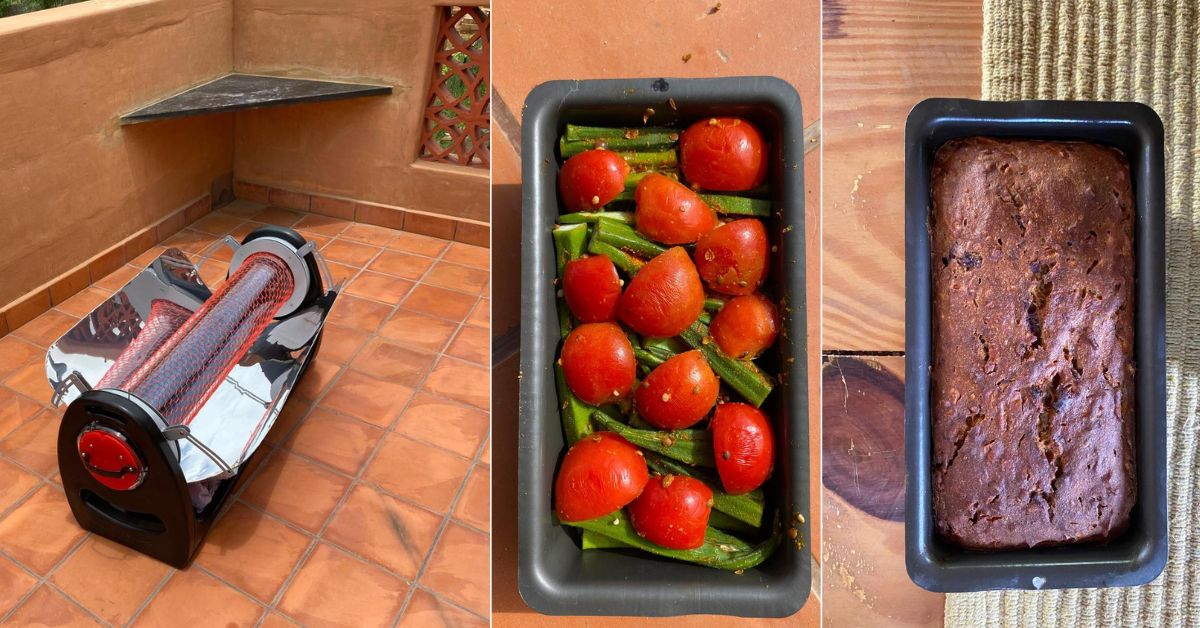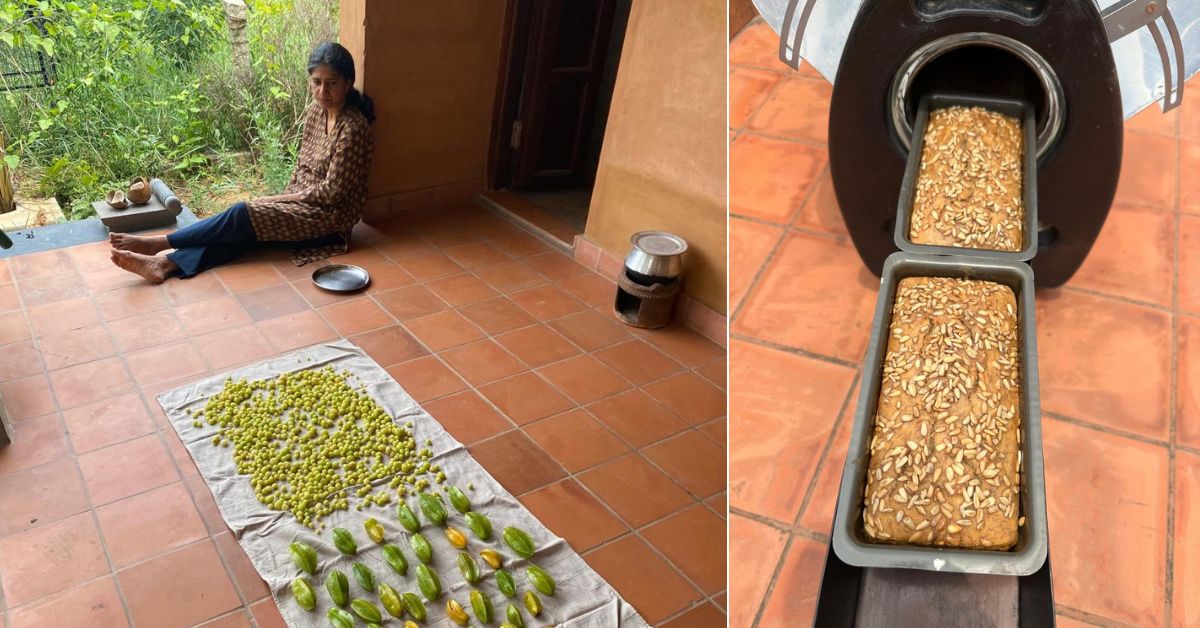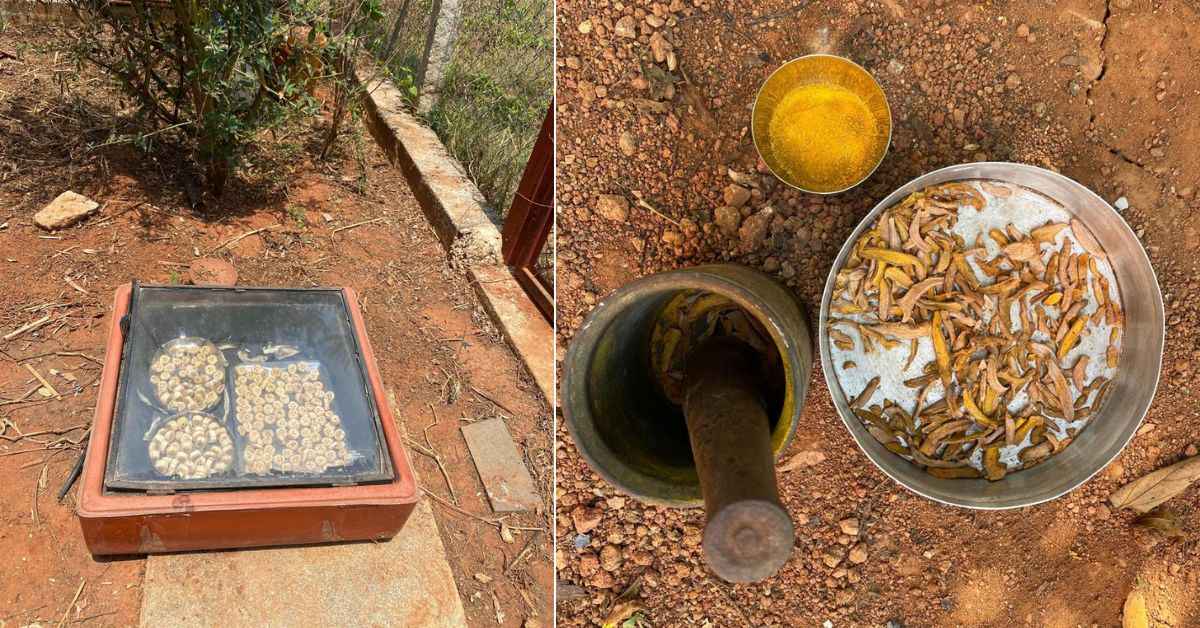Reva Jhingan Malik’s morning starts with chopping vegetables, soaking lentils, and cleaning the rice for the meal of the day. But, instead of heading towards her kitchen, she heads to the terrace of her off-grid home in Bengaluru where she has a small setup that cooks her food without requiring cooking gas, kerosene, electricity, coal or wood.
Interestingly, the food is cooked using direct sunlight!
Every morning at 9, she sets up her solar cooker and places all the vegetables, lentils, and rice in respective trays for a two-course meal. The food is cooked slowly in the sunlight and is ready within two hours.
Such is the impact of the solar cooker that Reva has not bought an LPG cylinder in the past four years.
Today, she uses the solar cooker to cook a variety of meals from poha (spiced flattened rice), baati (stuffed whole wheat dough balls), regular vegetables and lentils to baking cakes and breads, roasting peanuts, boiling milk and making tea.
We sat down with her to know how she is harnessing the solar energy for cooking and doing her bit towards sustainable living.

For depleting natural fossil fuels
Reva, who runs Primalise, a consulting firm in the city, was motivated to reduce her carbon footprint amid the talks around protecting the planet.
“We have been aware of the depleting fossil fuels. While it remains in the headlines for a few days, I believe not enough is really being done at individual household levels,” she shares with The Better India .
In the past five years, India’s imports of LPG surged 60 percent as demand increased rapidly while domestic supplies stagnated. Imports increased from 11.4 MMT in 2017-18 to 18.3 million metric tonnes (MMT) in 2022-23.
Domestic LPG production grew barely 4 percent in the five years to 2022-23 while consumption expanded 22 percent.
Reva says, “If we are talking about sustainability and teaching it to our children, are we ourselves adopting it? When it comes to environmental protection, we keep expecting the governments to act, but what have we done at our own individual levels towards the cause? That thought came as a turning point for me.”

She explored different ways to reduce her dependency on fossil fuels and go without it, at least at the daily living level.
“We were using fossil fuels in our cars and at home for cooking. So, we first eliminated this usage by getting an electric vehicle which was an easy choice. Second step was to go without LPG, and solar cooking was the alternative,” she adds.
Reva decided to discard LPG cylinders completely in 2020. Prior to that, she was using LPG cylinders that required to be refilled once every 2-3 months. Along with LPG, she was using her parents’ solar cooker intermittently.
“I realised we can actually go without LPG. In our country, the sun is so abundantly available to us, why not harness this energy as much as we can?” she adds.
Since then, solar cooking has become a primary source of cooking for Reva.

Cooking on LPG vs solar stove
Talking about the pros of solar cooking, Reva says, “Once, I add vegetables and other ingredients in the solar cooker then I don’t have to keep stirring the pan and monitor it. You just have to pull out the tray and everything is done. This system is more convenient for us than an LPG stove,” she says.
Reva’s solar cooker is about 2-feet in length and has three rectangular shaped containers to place various dishes like daal, vegetables, and rice separately.
“To reduce the cooking time, I use chana and rajma soaked overnight. One of the cons of this system is that we cannot make chapatis and add tadka to the daal. Instead, we have started eating wheat in the form of daliya and baati. Also, we roast and add cumin and coriander to make the lentil taste better,” she adds.
“It’s just simplified food choices for us now. The taste has now become secondary for us. However, we personally find the taste to be slightly better as the food is cooked slowly and the taste of the vegetable is retained,” she says.
Talking about the limitation of the set up, Reva says, “While we do most of the cooking in the solar cookers, we have also kept firewood chulha (stove) as a backup for cloudy and rainy days. We collect firewood from trees around our house and also use coconut shells and cow dung cakes as fuel. We use firewood chulha only once or twice a month.”
Another backup for cooking that they use during cloudy days and at night is their stored solar energy. Their house has a small 850 VA solar inverter that delivers enough charge for low-wattage electrical appliances.
She fondly talks about how she repurposed and converted an old box-type solar cooker into a food dehydrator. They use it to dehydrate and preserve excess fruits when they have a bounty. The contraption is also used for roasting grains, nuts and even drying homegrown turmeric.

For Reva, solar cooking is also cost-effective. “Initially, we would be forced to refill the LPG cylinder every 2-3 months. It would cost Rs 1,200 per refill. We invested Rs 18,000 for the solar cooker. This was a one-time investment as there is no other recurring expense and maintenance cost,” she says.
In India, the majority of households use LPG for cooking purposes and add to the emission burden. Reva urges people to harness solar energy that is abundantly available in the country.
“Most people think solar cooking is not convenient. With our experience of completely switching to solar cooking, we find it more convenient and easier than an LPG stove. Secondly, it’s guilt-free cooking. There is an immense satisfaction knowing our food is cooked in sunlight effortlessly. We are not exploiting our planet’s resources anymore,” says Reva.
“We have managed to close this energy loop for ourselves. If this becomes aspirational and households use sunlight as energy then collectively we will be able to mitigate the climate crisis. All of us can think of adopting solar cooking as our first step towards energy self-sufficiency,” she adds.
Source: LPG imports surge 60% in five years: By Sanjeev Choudhary for Economic Times, published on 16 February 2024.
Edited by Padmashree Pande. All photos: Reva Jhingan Malik.
No comments:
Post a Comment